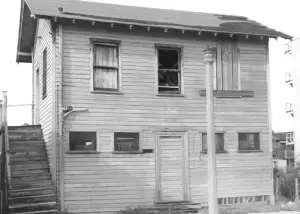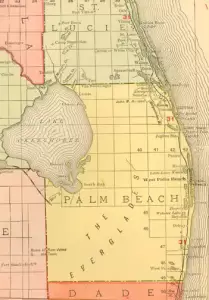Goods and Services: Government

The Town of West Palm Beach was incorporated in November 1894; it became the City of West Palm Beach in 1903. When its officials tried to annex the island of Palm Beach, its neighbor avoided the takeover by incorporating too. In 1919 West Palm Beach initiated several changes including reorganization of the police department, starting with eight men. The town marshal, Frank H. Matthews, was renamed police chief. The same year, the city built a city hall and hired its first city manager.

On May 10, 1899, the county seat of Dade County moved from Juno back to Miami, and residents associated with the government moved along with it. John Frohock, who was instrumental in effecting the change, served as sheriff after the change. Frohock only retired in 1909, when Palm Beach County was formed from the northern portion of what was then Dade County. Then in 1915 Palm Beach County and Dade County contributed nearly equal portions of land to create what is now Broward County.
The first of these changes was initiated in 1907, when a group of citizens discussed division at the hall over the Free Reading Room in West Palm Beach. Dade was the second largest county in the state (4,424 square miles), with an assessed tax valuation of $5,700,000 for 1905. The pro-division group wanted Dade County split just south of Fort Lauderdale, giving the new county about 60% of the area (2,500 square miles). Their argument: although the landowners from Fort Lauderdale to Stuart paid 60% of the taxes, most of it was spent further south, where paved roads were attracting new money. The northern part of the county relied on the generosity of Henry Flagler, who shipped road materials for free on his Florida East Coast Railroad. There was similar disparity with the amounts spent on schools.
The group empowered an eight-man committee to pursue their goal, which had to present a petition to officials in Tallahassee two months later, or wait two years for the next legislative session! Reactions varied but generally reflected geographic location: the north county was in favor of division; the Miami area was against it. The members of the committee were Louis William Burkhardt, Dr. Henry Clinton Hood, Max Sirkin, William I. Metcalf , Richard Jolley Chillingworth, Marion Eugene Gruber, John Clifford Stowers, A.P. “Gus” Anthony.
Four men traveled to Tallahassee to lobby for division. In May, the bill passed the senate almost two-to-one but was defeated in the House of Representatives with the same ratio. The committee found a candidate, George O. Butler (from Miami) for the House of Representatives to present their petition again. This time it quickly passed and, effective July 1, 1909, Palm Beach County became the 47th county in Florida, with West Palm Beach as the county seat.
The establishment of Palm Beach County initiated a flurry of change. The courthouse was located in the former schoolhouse at Clematis and Poinsettia (now Dixie Highway) avenues. The first county officers were appointed or elected. The Board of County Commissioners included Chairman W. H. DaCamara, C. W. McPherson, R. H. Rousseau, H. J. Niblack, and E. F. Bowers. The other public officials were: H. E. Stypmann, Tax Collector; Fred E. Fenno, Circuit Court Clerk; James M. Owens Sr., Tax Assessor; George B. Baker, Sheriff; T. M. Rickards Jr, County Judge; J. C. Harris, School Superintendent; and J. L. Grier, Supervisor of Registration.

